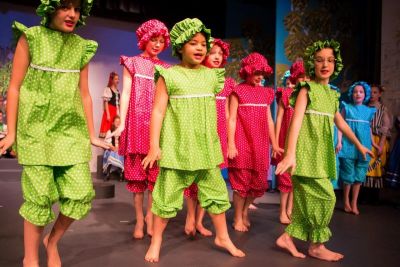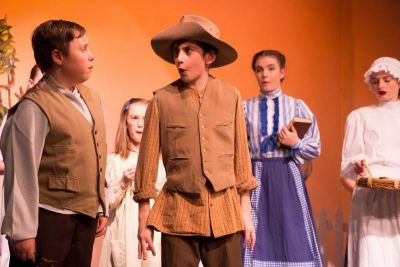Seven Little Australians
Seven Little Australians is a novel more than a hundred years old and has been continuously in print ever since it first told distinctly Australian stories of the seven children in the family of Captain Woolcot and his second wife Esther.
This stage adaptation by Joan Leslie, and the director Di Mason, is a revival of its original staging eighteen years ago and is a marvellous showcase of the talents of Hills Youth Theatre and its many students.
The play, like the original novel, is set in the late 1800s, when young families were starting to define themselves as Australian, so it’s as much about national identity as it is about the antics of children rebelling against the military parenting from their strict and distant father. This family’s children are ridiculed by other parents for pushing against the old English ‘stiff-upper-lip’ and military discipline, yet are secret heroes in the rest of the schoolyard. The main focus of this show is the most mischievous child Judy (born Helen, nicknamed Fizz, played by Jaimi Wilson), whose antics result in her being sent away to boarding school, only to run away and walk nearly eighty miles home, catching pneumonia on her way.
 The entire cast has been superbly drilled by the director – everyone knows their place and their lines; good use is made of the auditorium’s aisles to process the numerous performers to build up the set pieces at Bondi and the cricket game in the paddock. There are too many performers who give earnest, believable characters to single out everyone, though special mention must go to two of the Captain’s children, Meg (Claire Grosser), who has the right combination of a child wanting to be grown up but isn’t quite there, and Pip (Luka Bolte), who struggles with being the eldest boy yet constantly overrun by his sister Judy. They both give remarkable depth and naturalism to their young characters.
The entire cast has been superbly drilled by the director – everyone knows their place and their lines; good use is made of the auditorium’s aisles to process the numerous performers to build up the set pieces at Bondi and the cricket game in the paddock. There are too many performers who give earnest, believable characters to single out everyone, though special mention must go to two of the Captain’s children, Meg (Claire Grosser), who has the right combination of a child wanting to be grown up but isn’t quite there, and Pip (Luka Bolte), who struggles with being the eldest boy yet constantly overrun by his sister Judy. They both give remarkable depth and naturalism to their young characters.
The costumes from Paola Dal Pozzo are fabulous and plentiful (over three hundred for this show), keeping true to period in the magnificent formal dresses of the parents and the simple school uniforms of the girls and boys. The bold colours for the scene at Bondi are in stark contrast to the muted blues, purples and reds of a formal military family life.
Set design by Sonja Zodrow and the director follows those bold themes, with reversible flats placing the performers inside with wallpaper or outside with red brick. Additional doors at the extremes of each side of stage give secondary performing spaces without having to reset the stage continuously. Lighting from Peter Dandy is utilitarian, picking out the speakers when in the huge crowds.
The large tree positioned downstage right is the focus of the narration – the ‘Greek Chorus’ – offering context and foreshadowing events through words of schoolgirls: sometimes, direct to the audience, other times shared as schoolyard gossip, which was particularly effective and realistic.
 The show also incorporates song and dance, with an impressive dressing of the Maypole and an early 1900s dance in period bathing costume. The music is usually underscored in other scenes (Sonja Zodrow’s sound design using Bensound’s music), but comes to life here with a rhythmic band at the back of the stage, thumping the beat. The “Round the Barley” bushdance is no less notable. Songs such as “My Country”, “Happy Feet” and “I Do Like to be Beside the Seaside” are enthusiastically delivered in melody and movement.
The show also incorporates song and dance, with an impressive dressing of the Maypole and an early 1900s dance in period bathing costume. The music is usually underscored in other scenes (Sonja Zodrow’s sound design using Bensound’s music), but comes to life here with a rhythmic band at the back of the stage, thumping the beat. The “Round the Barley” bushdance is no less notable. Songs such as “My Country”, “Happy Feet” and “I Do Like to be Beside the Seaside” are enthusiastically delivered in melody and movement.
Hills Youth Theatre provides a great service to young actors in the Adelaide Hills, currently offering twelve classes across five days for children aged 5 to 18. The high standard of performing in this show is a tribute to the dedication of their teachers and the whole Youth Theatre staff. This show might seem an unusual choice, telling stories from 150 years ago, but even if the militaristic patriarchy from then has been (mostly) eradicated, its childhood struggles are no less real today. This show is educational for both historic and contemporary reasons, for the performers learning their craft and the audiences watching them.
Mark Wickett
Subscribe to our E-Newsletter, buy our latest print edition or find a Performing Arts book at Book Nook.

